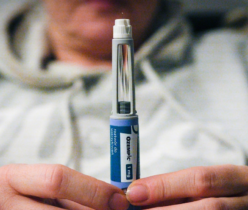We include products we think are useful for our readers. If you buy through links on this page, we may earn a small commission or other tangible benefit. Wellos and Healthline Media are owned by RVO Health. Here’s our process.
Healthline only shows you brands and products that we stand behind.
It’s possible to lose 10 pounds in 1 month due to lifestyle and dietary changes. However, losing this much weight in 1 month may not be a safe target for everyone.
Increasing exercise levels and modifying your dietary choices are important ways of managing your weight safely and effectively. Losing weight fast can be risky, however, so it’s best to focus on long-term goals.
We explain how specific changes might help you meet these goals.
Aerobic exercise — also known as cardio — is a type of physical activity that increases your heart rate to burn more calories and strengthen your heart and lungs.
One older
Current
Walking, jogging, boxing, biking, and swimming are just a few forms of cardio that can help burn calories and support weight loss.
Find some tips on workouts to get you started.
Cardio can help you burn more calories to increase weight loss.
Cutting down on nutrient-poor, refined carbs can improve the quality of your diet and further weight loss.
Refined carbs are those that are stripped of their nutrient and fiber content during processing, such as white bread.
Refined carbs are
For best results, replace refined carbs like white bread, breakfast cereals, and heavily processed packaged foods with whole grain products like quinoa, oats, brown rice, and barley.
Refined carbs, which are low in nutrients, can cause spikes and crashes in blood sugar levels. Research shows that a higher intake of refined carbs may be linked to higher body weight and increased belly fat.
To lose weight, you need to use more calories than you consume, either by decreasing your calorie intake or by increasing your daily physical activity.
A moderately active adult male needs around
Counting calories can keep you accountable and increase your awareness of how your diet may impact your weight loss.
An
However, cutting calories alone may not be a sustainable strategy for long-term weight loss. You’ll likely need to pair it with other diet and lifestyle modifications.
Additionally, not all carbs are the same. Whole grains can be high in calories, but they also provide fiber and other essential nutrients. Fiber will help you feel full and satisfied for longer, which can contribute to weight management.
Recording your intake with an app or food journal is a good way to get started.
Counting your calories can help increase weight loss when combined with other diet and lifestyle changes.
Choosing healthier beverages may also help with weight loss.
Soda, juice, and energy drinks may have high levels of added sugar and extra calories that can contribute to weight gain over time.
One
To support weight loss, cut out high calorie, sweetened beverages and aim to drink 34–68 fluid ounces (1–2 liters) of water throughout the day.
Soda, juice, and sports drinks are high in calories and can contribute to weight gain. Instead, opt for water to drink.
Slowing down and focusing on enjoying your food while listening to your body is an effective strategy to decrease intake and enhance feelings of fullness.
For example,
Taking smaller bites, drinking plenty of water with your meals, and reducing external distractions can help you eat more slowly to increase weight loss.
Eating slowly can decrease intake and improve feelings of fullness to enhance weight loss.
Fiber is a nutrient that moves through your body undigested, helping to stabilize blood sugar, slow stomach emptying, and keep you feeling full longer. Experts have linked foods that are high in fiber to weight loss.
Multiple studies demonstrate that fiber has a powerful effect on weight loss.
Current guidelines recommend consuming
Increasing fiber consumption has been linked to decreases in both calorie intake and body weight.
Increasing your intake of protein may help you lose weight. Starting the day with a healthy high protein breakfast, for instance, can leave you feeling satisfied and reduce the temptation to snack mid-morning.
Oats, yogurt, eggs, cottage cheese, and peanut butter are a few staple foods you can enjoy as part of a healthy, high protein breakfast.
Increased morning protein intake is associated with greater feelings of fullness, decreased calorie intake, and reductions in body weight and belly fat.
A lack of sleep can disturb your metabolic and hormonal balance. A
Most adults need at least
To increase your chances of getting enough sleep, try:
While sleep deprivation can increase hunger, getting enough sleep can increase the likelihood of successful weight loss.
Resistance training is a type of exercise that involves working against some type of force to build muscle and increase strength. It may not lead to rapid weight loss but it can help improve body composition while on a weight loss diet.
Examples include sit-ups and lifting weights.
This type of training may:
Get some tips on using bodyweight exercises as part of a resistance training program
Studies show that resistance training may preserve fat-free mass while you are losing weight.
Intermittent fasting involves cycling between periods of eating and fasting, with fasts typically lasting
Fasting
Learn about some ways to do intermittent fasting
Intermittent fasting can reduce your calorie intake by cutting down the number of hours in which you can eat.
Vegetables are nutrient-dense foods that supply vitamins, minerals, antioxidants, and fiber for a low number of calories.
A
For an easy way to raise your veggie quota, squeeze an extra serving or two into side dishes, salads, sandwiches, and snacks, or add spinach, kale, or other veggies to a smoothie.
Vegetable consumption is linked to increased weight loss and a lower risk of obesity. A higher intake of fiber from foods such as vegetables is also associated with decreased calorie intake.
Mayonnaise, teriyaki sauce, sour cream, butter, maple syrup, dips, spreads and other toppings can be high in calories. For example, a single tablespoon (13 grams) of mayonnaise can contain upwards of
Eliminating them from the diet is an easy way to cut calories.
Instead, use herbs and spices or low calorie options — like hot sauce, mustard, or horseradish — to flavor your food.
Many condiments and sauces are high in calories. Cutting them out or swapping them for low calorie alternatives could aid weight loss.
High-intensity interval training (HIIT) is a type of exercise that alternates between quick bursts of activity and brief recovery periods, keeping your heart rate up to boost fat burning and accelerate weight loss.
Adding HIIT to your routine can be an effective tool to support your weight loss journey.
To get started, try switching your cardio for one or two HIIT workouts per week or alternating between running and walking for 30 seconds at a time.
Other activities you can incorporate into HIIT include jumping jacks, squats, pushups, and burpees.
HIIT can burn more calories than other forms of exercise, thereby increasing weight loss and fat burning.
If you can’t squeeze in a full workout, adding small amounts of activity can chip away at your body weight.
The term “non-exercise activity thermogenesis” (NEAT)
It’s estimated that NEAT may account for
Making a few modifications to your daily routine can help you burn calories and speed up weight loss with minimal effort.
For instance, try:
Non-exercise activity thermogenesis (NEAT) can account for up to 50% of the total number of calories you burn each day. Moving more throughout the day can help you burn more calories to boost weight loss.
How long it takes to lose 10 pounds will depend on various factors, including your own bodily features and the strategies you use. Often, however, any weight that you lose quickly will likely go back on again, so a long-term plan may be more effective.
There’s no guarantee that you can lose 10 pounds rapidly, but combining strategies such as exercise, dietary changes, strategies that make you feel full for longer, and getting enough sleep can help you manage your weight over the long term.
This will depend on your current your activity levels and the types of foods you eat.
Eating more calories than you need will lead to weight gain, so reducing calorie intake will help you lose weight. You can use this weight loss calculator to help you figure out your goals and how to reach them.
Other tips include using a smaller plate at mealtimes and opting for a piece of fruit instead of a pastry for dessert or as a snack.
A collection of small modifications to your diet and lifestyle can help you lose weight, although 10 pounds in a month may not be a realistic target. In fact, rapid weight loss may pose risks to other aspects of your health.
Taking it one step at a time and making a few small changes each week can help you lose weight safely and keep it off long-term.
If you need to lose weight, speak with a registered dietitian nutritionist (RDN) about the best approach for you and which tips they recommend.
Use this tool to find an RDN.
Last medically reviewed on June 30, 2023
Our experts continually monitor the health and wellness space, and we update our articles when new information becomes available.
Current Version
Oct 30, 2023
Written By
Rachael Ajmera, MS, RD
Edited By
Yvette Brazier
Copy Edited By
Copy Editors
Jun 30, 2023
Medically Reviewed By
Alissa Palladino, MS, RDN, LD, CPT
VIEW ALL HISTORY
Share this article
OUR BRANDS


